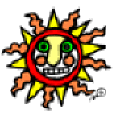En
español 
Classroom website
En
español |
Borgia Codix, Fragment Visiting the Mexican Museum of Anthropology is a must for any art and history
lover. One of the most amazing discoveries that attest to the sophisticated
culture of the Aztecs are their Codexes, exhibited at the Museum. In these well
organized, beautifully painted and scripted books, the Aztecs detailed their
lives, accomplishments, discoveries and beliefs. The Codice Borgia pictured
above is a replica of the Codex Borgia, a fragment of this long book. In this
fragment we observe a very large and distinctive structure with some activity
going around them. This temple is unusual in at least two ways. It is by far the
largest and most elaborate building illustrated in the codex. It is identified
as The Temple of Heaven by the presence in its roof of three bands of starts and
Venus symbols. Atop of this structure sits a flint helmeted deity form who
descends a white rope. This building has a pointed conical roof, a form
associated with Quetzalcoatl, the wind Deity. Quetzalcoatl appears seated on a
throne in the temple, where he is being addressed by Tlahuizcapantecuhtli, the
god of Venus as the morning star.
Visiting the Mexican Museum of Anthropology is a must for any art and history
lover. One of the most amazing discoveries that attest to the sophisticated
culture of the Aztecs are their Codexes, exhibited at the Museum. In these well
organized, beautifully painted and scripted books, the Aztecs detailed their
lives, accomplishments, discoveries and beliefs. The Codice Borgia pictured
above is a replica of the Codex Borgia, a fragment of this long book. In this
fragment we observe a very large and distinctive structure with some activity
going around them. This temple is unusual in at least two ways. It is by far the
largest and most elaborate building illustrated in the codex. It is identified
as The Temple of Heaven by the presence in its roof of three bands of starts and
Venus symbols. Atop of this structure sits a flint helmeted deity form who
descends a white rope. This building has a pointed conical roof, a form
associated with Quetzalcoatl, the wind Deity. Quetzalcoatl appears seated on a
throne in the temple, where he is being addressed by Tlahuizcapantecuhtli, the
god of Venus as the morning star.
The Village Present-day Mexico is dotted with a rich mix of Indian, Spanish, European
cultures. Each main city has a variety of arts and crafts that builds on their
historical heritage. Artisans in Guerrero specialize in producing Amate
paintings. Amate is the original paper used by the ancient Aztecs and Mayans in
their writings. This coarse and elegant paper is also a great canvass for
painting. Our artisans have learned the art of painting in amate from generation
to generation, each painter becoming more proficient as time progresses. In The
Village, one can see dozens of peasants in their town celebrations: playing with
a piñata, dancing, roasting a pig, watching a bird fight. The many colors of
this painting are a unique combination of bright tones against the brown
canvass.
Present-day Mexico is dotted with a rich mix of Indian, Spanish, European
cultures. Each main city has a variety of arts and crafts that builds on their
historical heritage. Artisans in Guerrero specialize in producing Amate
paintings. Amate is the original paper used by the ancient Aztecs and Mayans in
their writings. This coarse and elegant paper is also a great canvass for
painting. Our artisans have learned the art of painting in amate from generation
to generation, each painter becoming more proficient as time progresses. In The
Village, one can see dozens of peasants in their town celebrations: playing with
a piñata, dancing, roasting a pig, watching a bird fight. The many colors of
this painting are a unique combination of bright tones against the brown
canvass.
This information taken from: |
¡Gracias por su
visita! home |